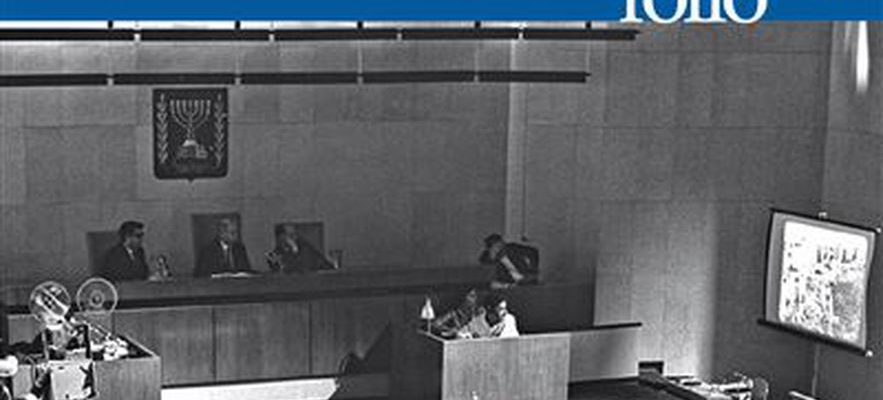Film, judge. From World War II to the invasion of Ukraine
By Christian Delage.
History folio, 576 pages, €13.50.
The rating of L’Express: 4/5
Film, judge. From World War II to the Invasion of Ukraine By Christian Delage.
© / story sheet
It’s “just an image” said Godard of the cinema, but it can lead someone to prison or to the gallows. From the beginning of the 20th century, photography, then film, made their entry into courtrooms, as evidence, with the Nuremberg trial as the culmination of a practice that had become commonplace. To the effects of the sleeve, we must now add camera movements, which have never been so numerous to record crimes and misdemeanors in the era of video surveillance and mobile phones. Historian Christian Delage, author of a remarkable documentary on the liberation of the Nazi camps filmed by Hollywood (From Hollywood to Nuremberg), retraces the history of the judicial uses of cinema, focusing on a few emblematic sequences, which are just as much those of the filmed trials; because the entry of the screens into the courtroom was quickly followed by that of the cameras.
In Filming, judging, an enriched reissue of a 2006 book, are recounted and analyzed dozens of images or videos that have become iconic, despite, or because of the horror: the bulldozers of the Bergen-Belsen camp in 1945, Klaus Barbie, impotent ghost at his trial in Lyon in 1987, Rodney King beaten up by police officers in Los Angeles in 1991, until the recent massacre of Boutcha in Ukraine. These images have had the right of life and death; whether or not they convinced a jury; above all, they have shaped our visual culture. Reference book, essential, Filming, judging imposes nothing on our gaze but questions it on each page, against all evidence. Because the most transparent image remains ambiguous, and if our society is primarily concerned about its trickery, its digital falsification, Delage draws our attention to the way in which it is presented and shown, with Nuremberg as a laboratory, an opportunity to a thousand questions still open: which image will be sufficiently convincing? When to project it? Is it more important than testimonies on the stand?
At the first trial of crimes against humanity, the historian recalls that the most striking effect came not from the films shown, but from the choice to light up the faces of the accused during the screening. As Joseph Kessel, special correspondent at the time, would write: “It was about surprising the movements to which this spectacle would force them.” It’s not just the image that is staged, it’s the projection device itself. If the Nazi crimes are at the heart of the book, the chapter on the beating of Rodney King remains the most disturbing, and undoubtedly the newest for French readers: Delage shows how the defense of the Los Angeles police officers managed to reclaim a yet indisputable, revolting video, by a clever use of freeze frame and commentary. A fascinating essay on the authenticity of images and their force of truth. Philippe Chevallier
Augustin Rouart. between father and son
By Jean-Marie Rouart.
Gallimard, 112 pages, €26.
The rating of L’Express: 4/5

Augustin Rouart. Between Father and Son By Jean-Marie Rouart.
© / Gallimard
What freshness! Yes, it may seem strange to speak thus of a French academician just in his eighties, but it is indeed the first word that arises when reading this beautiful book, a moving tribute to a father he nevertheless has, he writes , damn exhausted for years. This father is Augustin Rouart (1907-1997), a wonderful painter (little recognized during his lifetime), but a poor father figure, unfit for any role as an educator, and, above all, unable to provide his family with a decent apartment. . Even though he has some fine names in his “rich pedigree” (Julie Manet, Berthe Morisot), mentioned by Jean-Marie Rouart with A family in Impressionism (Gallimard, 2001), Augustin commits his family to a lifestyle of needy people.
Such is the severe statement drawn up by the rebellious teenager who was the author of the fires of power. Jean-Marie as a child was more placid, agreeing to endlessly play the role models for his father, a “whimsical fanatic” who has become a master in the art of fixing the features of fragility and innocence… And Jean-Marie Marie “mature” has been working for ages for the recognition of paternal talent, as evidenced by the many paintings reproduced in this album with aerial charm. Marianne Payot
The River Child
By Isabelle Amonou.
Dalva, 304 pages, €20.50.
The rating of L’Express: 3/5

The River Child By Isabelle Amonou.
© / Dalva
At the start, there was this original idea of hundreds of thousands of American migrants crossing Canada’s borders to escape the civil war triggered by global warming. An influx of refugees that Canada is trying to eradicate, by capturing, in particular, minors before sending them to Alaska. It is in this very near future (early 2030s) that Zoé, daughter of an Aboriginal mother (Algonquin), assimilated by force, and Thomas, a Parisian by adoption who returned to the country to bury his father, evolve. They have been separated for six years, since the unexplained disappearance of their little Nathan.
Zoé is convinced that he is still alive, there, in the forest, with the miners she tracks down for bounties. Thomas does not believe it, the reunion is stormy. So much for the plot of this novel which carries (too?) many themes – treatment of first peoples, climate change, migration, incest… –, but which turns out to be engaging and generous. PM
